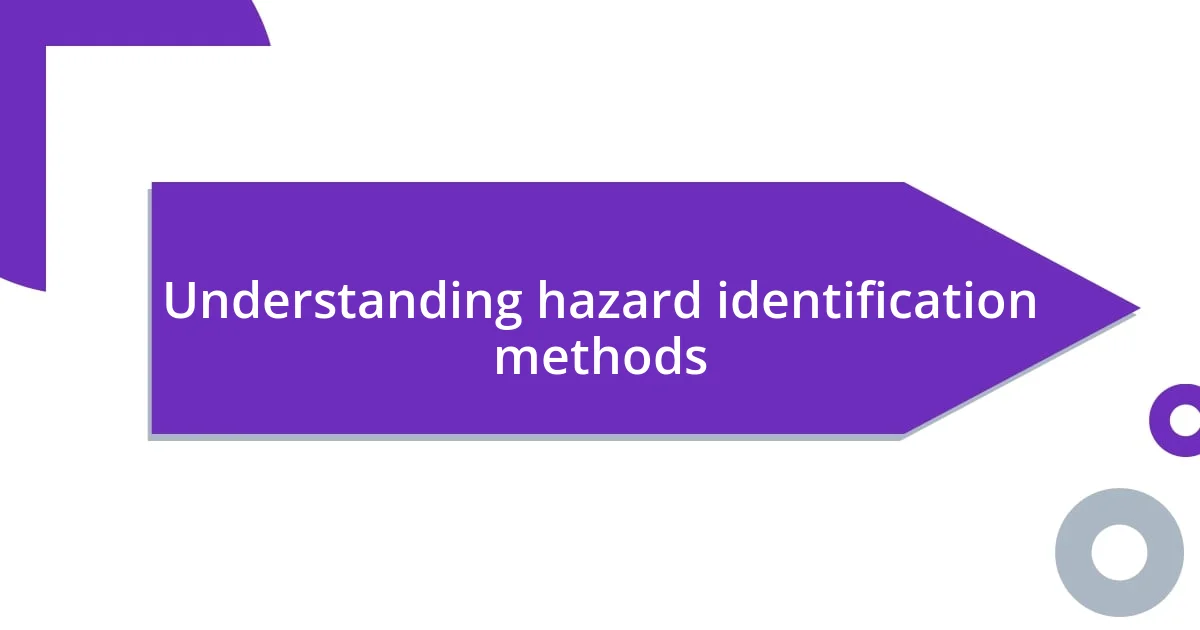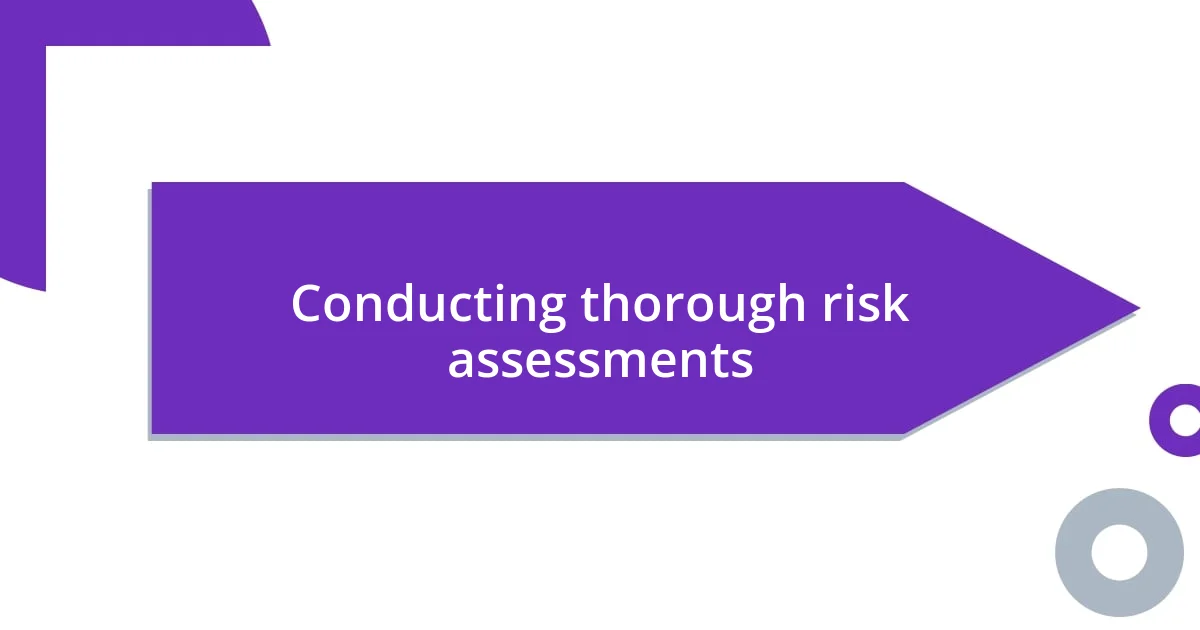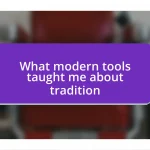Key takeaways:
- Utilizing diverse hazard identification methods, like brainstorming and checklists, promotes collaboration and uncovers hidden risks.
- Engaging diverse stakeholders and fostering an open communication environment enhances the identification process and encourages shared responsibility for safety.
- Implementing systematic documentation and continuous improvement practices, such as tracking metrics and feedback loops, strengthens hazard management and safety culture.

Understanding hazard identification methods
When I first delved into hazard identification methods, I was surprised by how many different approaches there are. From checklists to hazard mapping, each method has its own strengths and weaknesses. This diversity made me wonder: how do we choose the right one for our specific situation?
For instance, I remember a time when I used a brainstorming session to identify hazards in a manufacturing plant. Sitting down with the team, we shared our concerns and experiences, revealing risks that hadn’t been documented before. It was an eye-opening process, and it drove home the point that collaboration can uncover issues that might otherwise fly under the radar.
While some methods may feel overwhelming, like formal risk assessments, I’ve found that the right approach is often the one that resonates with the team’s culture. Honestly, engaging with these methods is like peeling back the layers of an onion; each layer you uncover brings clarity and potential solutions. Isn’t it fascinating how the way we perceive hazards can evolve with each new method we learn?

Key principles of hazard identification
When I reflect on the key principles of hazard identification, a few stand out that have greatly influenced my approach. First, it’s crucial to use a proactive mindset—always anticipating potential hazards before they arise. I recall a project where we adopted a forward-thinking approach, which led us to identify risks that could have resulted in significant downtime. Being proactive not only enhances safety but also saves time and resources in the long run.
Another essential principle is the importance of involving diverse perspectives. In one of my previous roles, I made it a point to include team members from different departments during hazard identification discussions. This variety enriched our conversations and revealed a spectrum of insights I hadn’t expected. With each voice contributing, we painted a more comprehensive picture of potential hazards, making the entire process more robust.
Lastly, thorough documentation is fundamental. I’ve found that having clear records not only helps in tracking identified hazards but also in assessing them over time. In my experience, systematic documentation allows for better follow-up and continuous improvement. I still remember when we revisited old records and discovered previously overlooked dangers—those sessions literally changed the way we approached hazard management.
| Key Principle | Description |
|---|---|
| Proactive Mindset | Anticipating potential hazards before they occur to enhance safety. |
| Diverse Perspectives | Engaging team members from various departments to gain a comprehensive view of risks. |
| Thorough Documentation | Systematic records tracking hazards for follow-up and continuous improvement. |

Tools for effective hazard identification
Effective hazard identification tools are essential in cultivating a safe environment. I’ve consistently found that employing a combination of qualitative and quantitative tools yields the best results. For instance, during a recent project, we integrated software tools for data analysis with traditional workplace inspections. The synergy between the two not only streamlined our hazard identification process but allowed us to visualize trends over time, which was incredibly enlightening.
Here’s a list of some of the tools I’ve personally found to be effective:
- Checklists: Always handy for systematic evaluations; they help ensure no hazard goes unnoticed.
- Risk Assessment Software: Enables data analysis and visualizes potential hazards, making it easier to identify trends.
- Brainstorming Sessions: Engaging the whole team to generate ideas often brings hidden hazards to light.
- Incident Reporting Systems: Encouraging reporting allows you to learn from past incidents and prevent future occurrences.
- Safety Audits: Regular audits provide a comprehensive overview and highlight areas for improvement.
In my experience, blending these tools allows for a thorough and approachable method to hazard identification, and it keeps everyone involved and informed.

Conducting thorough risk assessments
Conducting thorough risk assessments is an experience that often feels like piecing together a puzzle. I remember a time when we were tasked with assessing a manufacturing facility. As we walked the floors, I couldn’t help but notice how prior assessments had overlooked a series of small but critical hazards. Each one, when combined, painted a much clearer picture of the risks at play. I often ask myself, how many more hidden dangers lie in wait, simply because we failed to look closely enough?
It’s essential to engage fully with the environment and the people who interact with it daily. During a risk assessment, I once had a chat with a maintenance worker who brought up a seemingly minor concern about a slippery floor. That conversation opened the door to identifying several other linked issues, demonstrating that on-the-ground insights can be invaluable. Why wait for something to happen when a simple discussion can illuminate potential pitfalls?
Finally, while it’s important to evaluate what already exists, I’ve learned that it’s equally vital to challenge assumptions. In another project, we initially assumed the new safety equipment would eliminate certain risks. However, a deeper dive into the risk assessment revealed that the equipment could create new hazards if not properly used. This taught me that thorough risk assessments require a willingness to question and reassess, turning every stone in pursuit of safety.

Engaging stakeholders in hazard identification
Engaging stakeholders in hazard identification is truly a collaborative effort that has profound implications for safety. I remember a meeting where we brought together not just the safety team but also frontline workers and management. Listening to their experiences revealed overlooked hazards, which sparked a productive dialogue. Isn’t it fascinating how different perspectives can uncover issues that might remain hidden when working in silos?
In my experience, creating an open atmosphere for discussion is key. For instance, I implemented regular “hazard chat” sessions where team members could freely voice concerns or suggestions without fear. One day, a quiet employee spoke up about a recurring issue with equipment that the rest of us hadn’t noticed. It was a small moment, but it validated the importance of every voice in the room. How many critical insights might we miss if we don’t actively invite participation?
Moreover, I found that using visual aids, like charts or hazard maps, can really enhance stakeholder engagement. When we mapped out hazards together, the participants began to see interconnections that weren’t obvious before. It was like watching a light bulb go off! This shared visualization made it easier to prioritize and tackle issues collectively. Who would have thought that a simple chart could create such meaningful dialogue? Engaging stakeholders truly enriches the hazard identification process, fostering a culture of safety and shared responsibility.

Documenting and communicating hazards
Documenting and communicating hazards is where the rubber meets the road in safety management. I recall a project where we shifted from sporadic notes to a centralized digital dashboard for tracking hazards. It felt revolutionary. Suddenly, our team could see real-time updates, and it sparked a newfound clarity—who owned which issues, and how they were being addressed. Isn’t it amazing how accessible information can change the way we approach safety?
When I think about communication, I can’t help but remember a time when we conducted a safety briefing after identifying a series of hazards in our warehouse. I decided to use storytelling, sharing real-life scenarios about employees who encountered these hazards. The room was electric with engagement—people leaned in, nodding and reacting. It struck me that when we frame hazards in relatable ways, we create urgency and empathy around safety. How can we expect people to care about risks if we don’t help them understand the real impact?
Additionally, I’ve learned that visual documentation can make a difference. During one initiative, we began creating hazard posters that depicted not only the hazards but also the proper responses. I vividly remember an employee stopping me in the break room to express how those visuals helped him navigate potential issues during his shifts. It was a proud moment for me, realizing that clear communication could empower individuals in their safety journeys. What if we all made a conscious effort to ensure our documentation not only informs but also inspires action?

Continuous improvement in hazard identification
Continuous improvement in hazard identification is vital for enhancing workplace safety. I remember a time when our team initiated a feedback loop after completing hazard assessments. Each quarter, we gathered insights on what worked and what didn’t, which inspired innovative ideas. I found it invigorating to see how minor adjustments could lead to significant changes. Can you recall a time when small tweaks in a process generated unexpectedly positive outcomes?
One key aspect I’ve embraced is the importance of metrics. By tracking near misses and incidents, we can identify patterns that inform our hazard identification practices. I once analyzed the data from a six-month period and discovered that most incidents happened during shift changes. It was a revelation that led us to introduce tailored training sessions right before shifts. How pivotal can it be to glean actionable insights from our own experiences?
Additionally, fostering a learning culture has transformed our approach. When team members felt encouraged to share lessons learned from incidents, it created a foundation for continuous improvement. I vividly recall an incident report where a colleague detailed the near-miss from a poorly placed ladder. We shared that story in our next meeting, using it as a teaching moment that fostered camaraderie and vigilance. Isn’t it fascinating how a shared narrative can elevate our collective awareness and commitment to safety?














